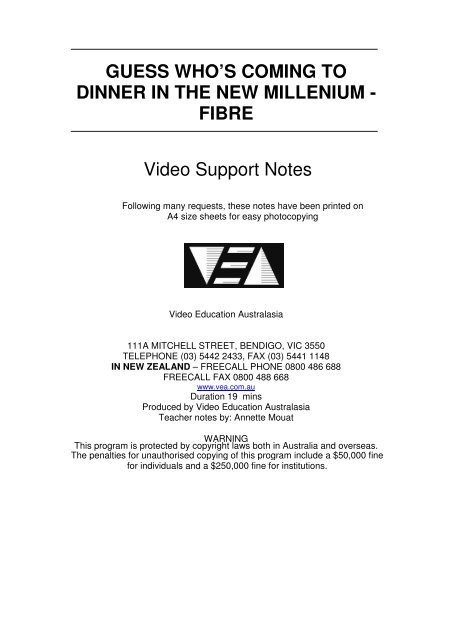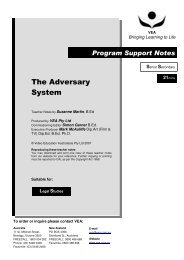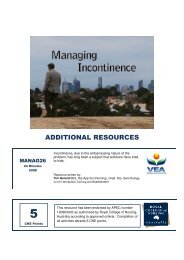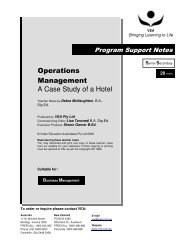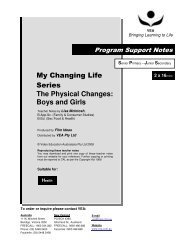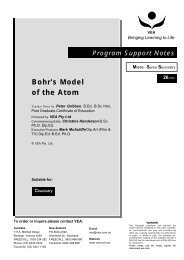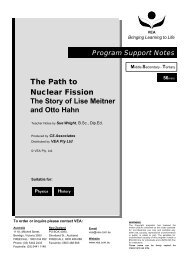guess who's coming to dinner in the new millenium - fibre - VEA
guess who's coming to dinner in the new millenium - fibre - VEA
guess who's coming to dinner in the new millenium - fibre - VEA
You also want an ePaper? Increase the reach of your titles
YUMPU automatically turns print PDFs into web optimized ePapers that Google loves.
GUESS WHO’S COMING TO<br />
DINNER IN THE NEW MILLENIUM -<br />
FIBRE<br />
Video Support Notes<br />
Follow<strong>in</strong>g many requests, <strong>the</strong>se notes have been pr<strong>in</strong>ted on<br />
A4 size sheets for easy pho<strong>to</strong>copy<strong>in</strong>g<br />
Video Education Australasia<br />
111A MITCHELL STREET, BENDIGO, VIC 3550<br />
TELEPHONE (03) 5442 2433, FAX (03) 5441 1148<br />
IN NEW ZEALAND – FREECALL PHONE 0800 486 688<br />
FREECALL FAX 0800 488 668<br />
www.vea.com.au<br />
Duration 19 m<strong>in</strong>s<br />
Produced by Video Education Australasia<br />
Teacher notes by: Annette Mouat<br />
WARNING<br />
This program is protected by copyright laws both <strong>in</strong> Australia and overseas.<br />
The penalties for unauthorised copy<strong>in</strong>g of this program <strong>in</strong>clude a $50,000 f<strong>in</strong>e<br />
for <strong>in</strong>dividuals and a $250,000 f<strong>in</strong>e for <strong>in</strong>stitutions.
SYNOPSIS<br />
GUESS WHO’S COMING TO DINNER IN THE NEW<br />
MILLENIUM? - FIBRE<br />
This video demonstrates and expla<strong>in</strong>s:<br />
• Def<strong>in</strong>ition of dietary <strong>fibre</strong><br />
• Health risks from a low <strong>fibre</strong> diet<br />
• Structure and sources of <strong>fibre</strong><br />
• Recommended daily dietary requirements of <strong>fibre</strong><br />
• Fibre and <strong>the</strong> digestive system<br />
• How dietary <strong>fibre</strong> m<strong>in</strong>imizes risk of certa<strong>in</strong> diseases<br />
• How <strong>to</strong> <strong>in</strong>crease <strong>fibre</strong> <strong>in</strong> <strong>the</strong> diet.<br />
SUGGESTED USES OF THE VIDEO<br />
• Health and Physical Education classes<br />
• Nutrition, Health and Human Development classes Food Technology classes where<br />
plann<strong>in</strong>g healthy diets is required<br />
• Science classes where <strong>the</strong> <strong>to</strong>pics of digestion and function of plant products <strong>in</strong> <strong>the</strong> diet<br />
are studied.<br />
SUGGESTED PRE-VIDEO DISCUSSION<br />
• The video will show us how a substance we eat <strong>in</strong> plant products and don’t really digest,<br />
helps us <strong>to</strong> rema<strong>in</strong> healthy and lessen <strong>the</strong> risk of some unpleasant diseases.<br />
• By watch<strong>in</strong>g Mischa, a young guy, learn<strong>in</strong>g about this substance called dietary <strong>fibre</strong>, you<br />
should be able <strong>to</strong> get a good idea about why it is important <strong>to</strong> eat enough <strong>fibre</strong>.<br />
• The video tells how <strong>to</strong> <strong>in</strong>crease <strong>the</strong> amount of faeces we do daily and thus improve our<br />
chances of good health.<br />
DETAILED VIDEO CONTENT<br />
Mischa is shown eat<strong>in</strong>g white bread while a voice over expla<strong>in</strong>s that <strong>fibre</strong> used <strong>to</strong> be called<br />
roughage and how it protects us from <strong>the</strong> “diseases of affluence” such as colon cancer,<br />
coronary heart disease, diabetes, diverticulitis, high cholesterol and obesity. It also helps<br />
control diabetes and relieves constipation.<br />
WHAT IS FIBRE? Fibre is <strong>the</strong> cell walls of plants, <strong>the</strong> sk<strong>in</strong> and flesh of fruit and vegetables<br />
and <strong>the</strong> outer cover<strong>in</strong>g of gra<strong>in</strong>s such as wheat and rice.<br />
The <strong>fibre</strong> content of a lettuce leaf and cabbage leaf is compared – <strong>the</strong> easily <strong>to</strong>rn lettuce leaf<br />
conta<strong>in</strong>s less <strong>fibre</strong> than <strong>the</strong> <strong>to</strong>ugher cabbage leaf.<br />
Strong fibrous cell walls prevent plants be<strong>in</strong>g liquids, not<strong>in</strong>g that milk has approximately about<br />
90% water which is similar <strong>to</strong> <strong>the</strong> water content of many fruit and vegetables. If someone<br />
chews/eats fruit it takes <strong>the</strong>m longer than dr<strong>in</strong>k<strong>in</strong>g a fluid, consequently it is harder <strong>to</strong> over<br />
consume solid foods conta<strong>in</strong><strong>in</strong>g dietary <strong>fibre</strong>.<br />
Carbohydrate classification is described as<br />
• Available e.g. starches and sugars which are digested <strong>in</strong> <strong>the</strong> s<strong>to</strong>mach and small <strong>in</strong>test<strong>in</strong>e;<br />
• Unavailable e.g. cellulose, hemicelluloses and pect<strong>in</strong> which pass through <strong>the</strong> s<strong>to</strong>mach,<br />
undigested <strong>to</strong> <strong>the</strong> colon and are <strong>the</strong> most important types of <strong>fibre</strong>.<br />
There are also <strong>the</strong> non-carbohydrate types of <strong>fibre</strong> called Lign<strong>in</strong>, gums and mucilages.<br />
Cellulose makes up <strong>the</strong> structure of plant cell walls and is found <strong>in</strong> all plant foods e.g.<br />
wholegra<strong>in</strong>s, brans, wholemeal bread, dried fruit and <strong>the</strong> cabbage family,<br />
Hemicelluloses are found <strong>in</strong> plant tissues; especially cereal husks/bran and <strong>the</strong>y have a high<br />
water-b<strong>in</strong>d<strong>in</strong>g capacity.<br />
Pect<strong>in</strong> is found <strong>in</strong> fruit especially apples and citrus fruit and it helps slow down nutrient<br />
absorption <strong>in</strong> <strong>the</strong> <strong>in</strong>test<strong>in</strong>e.<br />
Lign<strong>in</strong> is <strong>the</strong> only component of <strong>fibre</strong> that escapes digestion, even by bowel bacteria and is<br />
found <strong>in</strong> cereals and old woody vegetables.<br />
WHAT DOES FIBRE DO? In our mouth, saliva <strong>in</strong>creases food’s digestibility. Prote<strong>in</strong>,<br />
carbohydrate, m<strong>in</strong>erals and vitam<strong>in</strong>s are absorbed from <strong>the</strong> s<strong>to</strong>mach <strong>to</strong> <strong>the</strong> small <strong>in</strong>test<strong>in</strong>e,<br />
2
GUESS WHO’S COMING TO DINNER IN THE NEW<br />
MILLENIUM? - FIBRE<br />
and <strong>the</strong>n lastly fat is absorbed. The rema<strong>in</strong><strong>in</strong>g food residue is passed <strong>to</strong> <strong>the</strong> large <strong>in</strong>test<strong>in</strong>e or<br />
colon. Normal bacteria feed on <strong>the</strong> hemicellulose <strong>fibre</strong> and <strong>the</strong> more <strong>the</strong> bacteria multiply, <strong>the</strong><br />
more faeces we produce. The <strong>fibre</strong> also soaks up liquid wastes from <strong>the</strong> colon and makes<br />
<strong>the</strong> faeces softer, bulkier and easier <strong>to</strong> remove from <strong>the</strong> body.<br />
HOW MUCH FIBRE SHOULD WE EAT? Our early ances<strong>to</strong>rs did not have processed food so<br />
<strong>the</strong>ir diets were higher <strong>in</strong> <strong>fibre</strong>. Archive footage of African Villagers is shown and expla<strong>in</strong>s<br />
how <strong>the</strong>se people who have high <strong>fibre</strong> diets suffer very few diseases of affluence. Average<br />
villagers eat about 80g which is 4 times <strong>the</strong> <strong>fibre</strong> consumed by average western people who<br />
consequently pass only about 100g faeces daily compared <strong>to</strong> <strong>the</strong> villagers 450g. Dieticians<br />
recommend we eat at least 30g <strong>fibre</strong> daily <strong>in</strong>stead of <strong>the</strong> average 20g.<br />
The more <strong>fibre</strong> we eat <strong>the</strong> faster it passes through <strong>the</strong> body – food passes through <strong>the</strong> body <strong>in</strong><br />
about 24 hours if <strong>the</strong> dietary <strong>fibre</strong> is adequate. If <strong>the</strong> diet is low <strong>in</strong> <strong>fibre</strong> constipation is likely<br />
because <strong>the</strong> bacteria <strong>in</strong> <strong>the</strong> bowel do not multiply and <strong>the</strong> faeces, result<strong>in</strong>g are small, hard<br />
and dry, because <strong>the</strong>y soak up less liquid. Constipation can lead <strong>to</strong> o<strong>the</strong>r causes of<br />
discomfort such as hiatus hernia, varicose ve<strong>in</strong>s and haemorrhoids, so eat<strong>in</strong>g <strong>fibre</strong> rich foods<br />
can lessen <strong>the</strong>se.<br />
HEALTH RISKS FROM A LOW FIBRE DIET<br />
Cancer of <strong>the</strong> Colon – it is thought that a high <strong>fibre</strong> diet, by help<strong>in</strong>g <strong>the</strong> body dispose of waste<br />
products faster, reduces risk of cancer.<br />
Diabetes – high <strong>fibre</strong> diets tend <strong>to</strong> even out fluctuations <strong>in</strong> blood sugar because it slows down<br />
absorption of nutrients. Also high <strong>fibre</strong> foods require more chew<strong>in</strong>g and create a feel<strong>in</strong>g of<br />
fullness, which can aid weight loss and improve diabetic control.<br />
Heart Disease – some types of <strong>fibre</strong> have been found <strong>to</strong> lower high blood cholesterol levels,<br />
which is sometimes associated with heart disease.<br />
Obesity – is l<strong>in</strong>ked <strong>to</strong> high blood pressure, diabetes and heart disease, so dietary <strong>fibre</strong> foods,<br />
because <strong>the</strong>y are generally low <strong>in</strong> energy rich fats, help prevent obesity. 150g of chocolate,<br />
340g of bread and 1000g of pota<strong>to</strong> all have <strong>the</strong> same amount of energy <strong>in</strong> <strong>the</strong>m. Foods high<br />
<strong>in</strong> fat and sugar do not make us feel as full as high <strong>fibre</strong> foods. Notably <strong>fibre</strong> has no kilojoules<br />
so does not provide energy.<br />
HOW DO WE GET MORE FIBRE IN OUR DIETS?<br />
The Healthy Eat<strong>in</strong>g Pyramid, which shows <strong>the</strong> foods we should eat most of – fruit, vegetables<br />
and cereals, is a guide.<br />
Mischa is shown with a low <strong>fibre</strong> breakfast, lunch, <strong>d<strong>in</strong>ner</strong> and snacks <strong>to</strong>tal<strong>in</strong>g 9g of <strong>fibre</strong>, and<br />
<strong>the</strong>n is shown with a high <strong>fibre</strong> menu for one day conta<strong>in</strong><strong>in</strong>g about 40g of <strong>fibre</strong>.<br />
Cook<strong>in</strong>g foods does not reduce <strong>the</strong>ir <strong>fibre</strong> content, but cook<strong>in</strong>g does make some foods more<br />
palatable and digestible. Much of <strong>the</strong> <strong>fibre</strong> is <strong>in</strong> <strong>the</strong> sk<strong>in</strong>s of fruit and vegetables.<br />
Mischa looks at breakfast cereal labels for <strong>fibre</strong> content (and notes that some have up <strong>to</strong> 50%<br />
sugar). Coco Pops conta<strong>in</strong> .6g <strong>fibre</strong> <strong>in</strong> every 100g, while Vitabrits have 12g per 100g.<br />
Mischa mixes himself an <strong>in</strong>terest<strong>in</strong>g breakfast food (fresh muesli) conta<strong>in</strong><strong>in</strong>g apple, oats,<br />
sultanas, banana, strawberry, and skim milk. Mischa is also <strong>to</strong>ld that porridge is a very good<br />
high <strong>fibre</strong> breakfast food.<br />
3
GUESS WHO’S COMING TO DINNER IN THE NEW<br />
MILLENIUM? - FIBRE<br />
STUDENT WORKSHEET:<br />
DIETARY FIBRE<br />
1. The follow<strong>in</strong>g diseases and conditions: colon cancer, coronary heart disease, diabetes,<br />
diverticulitis, high cholesterol and obesity are commonly called <strong>the</strong> “diseases of<br />
_______________”.<br />
2. Which parts of plants is <strong>the</strong> <strong>fibre</strong>?<br />
_______________________________________________________________________<br />
3. Why are lettuce leaves easier <strong>to</strong> tear than cabbage leaves?<br />
_______________________________________________________________________<br />
4. Milk and oranges both conta<strong>in</strong> approximately <strong>the</strong> same amount of water. Expla<strong>in</strong> why<br />
you can dr<strong>in</strong>k milk and not whole peeled oranges.<br />
_______________________________________________________________________<br />
_______________________________________________________________________<br />
5. Starches and sugars are called ________________ carbohydrates.<br />
6. Cellulose, hemicellulose and pect<strong>in</strong> that pass through <strong>the</strong> body undigested are called<br />
__________________ carbohydrates.<br />
7. What multiplies and feeds on <strong>the</strong> hemicellulose <strong>in</strong> our colon or large <strong>in</strong>test<strong>in</strong>e?<br />
_______________________________________________________________________<br />
8. What does <strong>the</strong> <strong>fibre</strong> soak up from <strong>the</strong> colon so that <strong>the</strong> faeces are softer, bulkier and<br />
easier <strong>to</strong> expel from our bodies?<br />
_______________________________________________________________________<br />
9. Why did our very early hunter and ga<strong>the</strong>rer ances<strong>to</strong>rs have diets high <strong>in</strong> <strong>fibre</strong>?<br />
_______________________________________________________________________<br />
_______________________________________________________________________<br />
10. How many grams of <strong>fibre</strong> should we aim <strong>to</strong> eat daily?<br />
_____________________<br />
11. If dietary <strong>fibre</strong> <strong>in</strong> your diet is adequate, about how long from <strong>the</strong> time of eat<strong>in</strong>g does it take<br />
for food waste <strong>to</strong> pass from <strong>the</strong> body?<br />
_____________________<br />
12. When constipation occurs why are <strong>the</strong> faeces small, hard and dry?<br />
_______________________________________________________________________<br />
_______________________________________________________________________<br />
4
GUESS WHO’S COMING TO DINNER IN THE NEW<br />
MILLENIUM? - FIBRE<br />
13. Why is it that a high <strong>fibre</strong> diet may reduce <strong>the</strong> risk of colon cancer?<br />
_______________________________________________________________________<br />
_______________________________________________________________________<br />
14. How can a high <strong>fibre</strong> diet assist a person with diabetes?<br />
_______________________________________________________________________<br />
_______________________________________________________________________<br />
15. Why does a high <strong>fibre</strong> diet lessen <strong>the</strong> risk of be<strong>com<strong>in</strong>g</strong> obese?<br />
_______________________________________________________________________<br />
_______________________________________________________________________<br />
16. What foods can people eat more of <strong>to</strong> <strong>in</strong>crease <strong>the</strong> <strong>fibre</strong> content of <strong>the</strong> diet?<br />
_______________________________________________________________________<br />
_______________________________________________________________________<br />
17. What does cook<strong>in</strong>g do <strong>to</strong> <strong>the</strong> <strong>fibre</strong> present <strong>in</strong> foods?<br />
_______________________________________________________________________<br />
_______________________________________________________________________<br />
18. How many grams of dietary <strong>fibre</strong> does 100g of <strong>the</strong> follow<strong>in</strong>g conta<strong>in</strong>?<br />
Coco Pops _________________ Vitabrits _____________________<br />
5
GUESS WHO’S COMING TO DINNER IN THE NEW<br />
MILLENIUM? - FIBRE<br />
OTHER SUGGESTED ACTIVITIES FOR STUDENTS<br />
1. Us<strong>in</strong>g dietary food tables, such as The Nutritional Values of Australian Foods, design a<br />
table or bar graph that depicts <strong>the</strong> dietary <strong>fibre</strong> content of 8 different breakfast cereals.<br />
Ensure that you give <strong>the</strong> table a name and clearly label <strong>the</strong> side and base of <strong>the</strong><br />
table/graph.<br />
2. Do as above (1.) only compare a range of fruit and vegetables<br />
3. Us<strong>in</strong>g <strong>the</strong> food tables, f<strong>in</strong>d and write down 10 very different foods that have no <strong>fibre</strong> at all.<br />
4. Us<strong>in</strong>g your artistic talents or a computer, plan and present on a pla<strong>in</strong> piece of A4 paper, a<br />
tasty one day high <strong>fibre</strong> diet suitable for a teenager, <strong>in</strong>clud<strong>in</strong>g breakfast, lunch, <strong>d<strong>in</strong>ner</strong> and<br />
snacks.<br />
5. Prepare an attractive three-fold leaflet from A4 paper that would help educate people<br />
about dietary <strong>fibre</strong>. It should be attractively presented, easy <strong>to</strong> read with <strong>the</strong> most<br />
important facts about <strong>fibre</strong>, and be suitable <strong>to</strong> be published and left <strong>in</strong> a Health Cl<strong>in</strong>ic or<br />
Doc<strong>to</strong>rs’ wait<strong>in</strong>g room.<br />
O<strong>the</strong>r Relevant <strong>VEA</strong> Material<br />
Guess Who’s Com<strong>in</strong>g <strong>to</strong> D<strong>in</strong>ner –Sugar/Salt/Fat<br />
Five Common Food Myths<br />
Five More Common Food Myths<br />
Nutrition Through <strong>the</strong> Lifespan (5 part series)<br />
Food Mach<strong>in</strong>e Series (12 part series)<br />
Chang<strong>in</strong>g <strong>the</strong> Australian Diet<br />
The Australian Guide <strong>to</strong> Healthy Eat<strong>in</strong>g<br />
Good Enough <strong>to</strong> Eat: A Closer Look at Genetically Modified Foods<br />
For details on many o<strong>the</strong>r programs, see our 2000 Catalogue <strong>in</strong> your school or r<strong>in</strong>g us on<br />
1800 034 282<br />
Our <strong>VEA</strong> Multimedia Education Department welcomes your observations and<br />
comments.<br />
Please feel free <strong>to</strong> address your correspondence <strong>to</strong>:<br />
<strong>VEA</strong> 111A MITCHELL STREET<br />
BENDIGO VIC 3550<br />
OR CALL 1800 034 282<br />
FAX (03) 5441 1148<br />
NEW ZEALAND<br />
CALL 0800 486 688<br />
FAX 0800 486 668<br />
6


